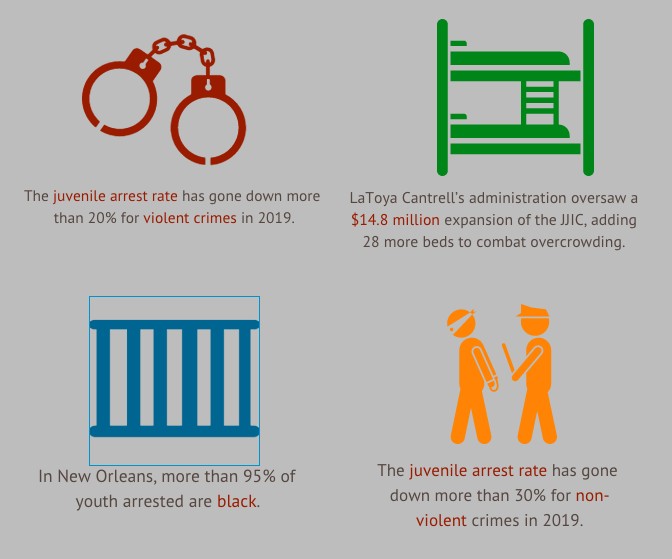With an overly punitive juvenile justice system, New Orleans is failing its children
Nketiah Berko is a research assistant with the Oxford-Tulane Developmental Justice Network studying juvenile justice in New Orleans and Barbados and was formerly an investigative intern at the Orleans Public Defenders office.
On Aug. 15, a disturbance broke out at the Orleans Parish Juvenile Justice Intervention Center, resulting in the New Orleans Police Department SWAT team being called to the scene. During the episode, three incarcerated youths, barricading themselves in their cell, reportedly fashioned homemade weapons. Though no one was harmed, the incident underscores the alarming deficiencies of the city’s juvenile justice approach.
The recent disturbance at the JJIC is only the latest, albeit most dramatic, example of New Orleans’ troubled juvenile justice experience. To be clear, the city does not face any surge of violent youth, despite frenzied rhetoric to the contrary. Though the district attorney’s office has railed about a supposed rise in juvenile arrests, the juvenile arrest rate has gone down for both violent and non-violent crimes in 2019.
Juvenile arrests are way down over last year, but there was a surge at this time last year. In real terms juvenile arrests (brought to court) have been the same over the last few years. pic.twitter.com/0ejpyD8OqD
— NOLA Community Advisory Group — Safety & Justice (@SJNOLACAG) June 26, 2019
Nonetheless, the juvenile justice system remains rife with serious issues. In recent years, the JJIC, formerly the Youth Study Center, has been understaffed, overcrowded and unsafe for detained youth and staff alike. Children receive little mental health care, and they face overly punitive disciplinary measures, such as reduced visitation privileges, which only serve to further isolate them.
According to a 2017 Juvenile Detention Alternatives Initiative Facility Assessment of the then-Youth Study Center, the facility was judged to be nonconforming with nearly half of the JDAI’s standards for youth detention. These facts are damning.
To its credit, the city has taken some steps toward addressing some of the more egregious problems faced by the JJIC. The Landrieu administration initiated a $14.8 million expansion of the facility, adding 28 more beds to accommodate juvenile offenders confined at the adult jail. Moreover, the city has sought to expand mental health care access and address understaffing concerns.
I convened a meeting yesterday with critical stakeholders in our justice system—from the DA to the Public Defenders, the Youth Study Center, the Supt. of the NOPD and judges from the Criminal and Juvenile courts. pic.twitter.com/LjrvBVSU6x
— Mayor LaToya Cantrell (@mayorcantrell) June 13, 2019
Despite these efforts, however, the current approach to delinquent children remains fundamentally misguided. According to the National Research Council, juvenile institutionalization is less effective than community programs at reducing recidivism rates and improving youth development. The city’s goal, therefore, should be to gradually move away from facilities far removed from families.
Such reform is more than possible, and it is far from unprecedented. In Missouri, lawmakers shuttered youth prisons, replacing them with decentralized, community-placed facilities aimed at rehabilitation rather than retribution. Consequently, according to the Missouri Division of Youth Services, less than 7% of youth reoffend. Additionally, more than 75% of children in the program make “at least one year of academic progress for every year in confinement,” a stark contrast to the paltry national average of 25%.
In New Orleans, more than 95% of youth arrested are black. More than 80% of youth arrests are for nonviolent crimes. Such glaring inequities point to both socioeconomic disparities and bias in an already unforgiving criminal justice system.
Roughly 66 kids in this community, less than a hundred, have been arrested this year for car burglaries and are in need of the services in this room. That is doable. That is not the Thunderdome of juveniles running rampant.
— Jason Williams (@RunWithJason) June 26, 2019
Instead of receiving help and empathy, however, these children face estrangement from society and the demagoguery of opportunistic politicians. Even the language used to describe the juvenile justice system betrays its cold, unfeeling nature.
Instead of children, we encounter “juvenile offenders” and “inmates.” In such an environment, they quickly devolve into “super-predators,” stripped of the nuance, charms, and yes, the flaws, which make them kids.
New Orleans may be failing its children, but the city is far from alone in doing so. For years, the U.S. juvenile justice system, much like its adult counterpart, has been punitive and dehumanizing. Other more effective, more humane alternatives exist.
We owe it to both our children and our consciences to implement them.
Correction: an earlier version of this article stated that the Cantrell administration oversaw the JJIC expansion in order to alleviate overcrowding at the facility. While the expansion was completed after Mayor Cantrell took office, the Landrieu administration broke ground on the initiative, intending to accommodate juvenile offenders held at the Orleans Justice Center rather than strictly to combat overcrowding.
Your donation will support the student journalists of Tulane University. Your contribution will allow us to purchase equipment and cover our annual website hosting costs.



